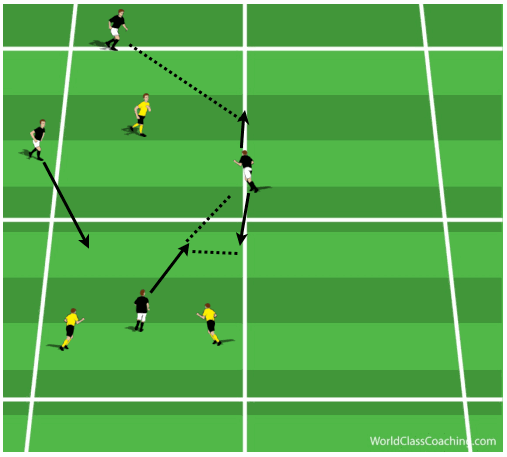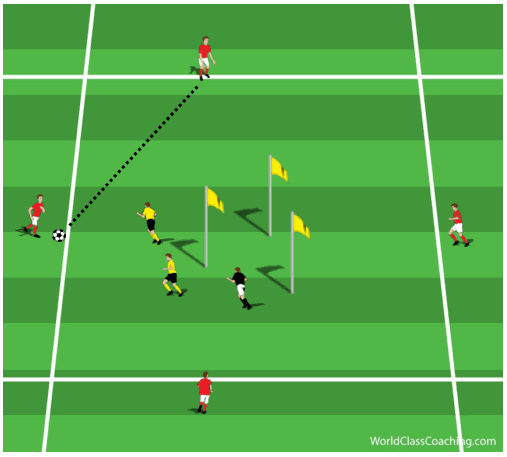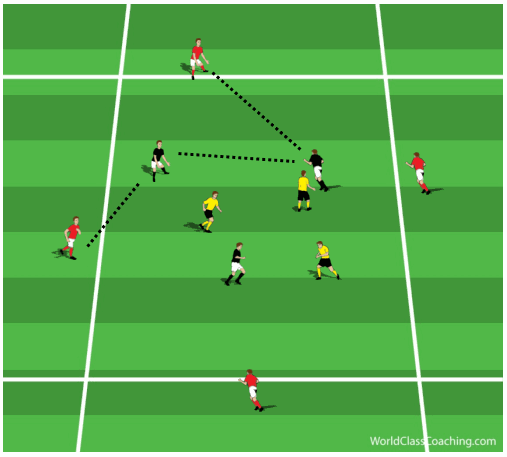By Eric Clermont -
While the use of rondos in youth practices is commonplace, many coaches use the activity merely as a technical exercise to warm players up before starting the major part of their practice. Of course, the activity is a great tool to teach the key aspects of maintaining possession; namely the angle and distance of support, mobility off the ball and the technical aspects of passing such as weight and disguise of pass.
The group of activities below give another perspective of the rondo, namely the use of the activity to coach the functions of players in certain positions. Specifically, the following activities give coaches ideas of how to coach players in possession in the defensive third trying to keep the ball, and attempting to find players in midfield, as well as ideas on how to coach transition during a rondo activity.
Rondo 1: Area of low pressure to an area of high pressure
Organization
2x 10x10 grids set up next to each other. In one grid, players play in a 3 v 1 rondo. In the other grid, the attacking team (wearing black) are outnumbered 1 v 2. Players in the 3 v 1 grid wearing black (could be a centre back and two full backs or a centre midfielder and two wingers) must play 5 passes and then must choose when to play forward to their player in the other grid (DM or ST). Once playing into the grid, 2 players can join this player to attempt to keep possession, creating a 3 v 2 in that grid. They score a point if they can play in behind the two defenders (at the line).
Coaching Points
- Angles/distance of support
- Mobility by attacking player in 1 v 2 to create space to receive the ball
- Decision of when to play forward and when to keep possession
- Mobility of players to get in support of the player who is 1 v 2 when outnumbered
Rondo 2: Finding Busquets
Organization: 12 x 12 grid with a 3 x 3 x 3 triangle set up in the middle of the grid (with poles). Players play a 4 v 2+ 1 with the red players keeping possession and trying to find the players in black inside the triangle. Defenders win a point if they gain possession or if they kick the ball out of bounds 3 times. Attackers win a point when they play the defensive midfielder inside the triangle.
Coaching Points
- Mobility and creation of space by the DM inside the grid Vs 2 defenders
- Speed of play and mobility of the player in black
- Decision making of the 4 in red of when to attempt to play into triangle. Risk v reward
Rondo 3: 3 v 3 + 4
Organization
15 x 15/ 20 x 20 grid. Teams in the middle of the grid play 3 v 3 and can use the 4 neutral players on the outside to keep possession. Teams win a point for 7 consecutive passes (passes between 2 neutral players do not count).
Coaching Points
- Same as above
- Mobility of the 3 CMs when out of possession (must be complimentary)
Rondo 4: Transitional Rondo
Organization
A small 8 x 8 box in the corner of a 32 x 32 box. Players in black attempt to keep the ball in a 3 v 1 in the small possession grid. Every 7 consecutive passes they play, they score one point. As soon as the yellow player wins the ball, they play outside to the big grid and then, the black team can go and defend (while the yellow also goes in to the grid) 6 v 3. Yellow team now score if they play 7 passes consecutively. If the ball goes out of bounds, restart from the small rondo box in the corner. *The practice could depict a DM breaking up play in midfield against three strikers and playing the ball back to his back line to keep possession.*
Coaching Points
- Same as above during the rondo
- Attacking transition of the yellow team when they win possession
- Defensive transition from the black team when they lose it
By Eric Clermont - NSCAA Premier Diploma, USSF A License Candidate





